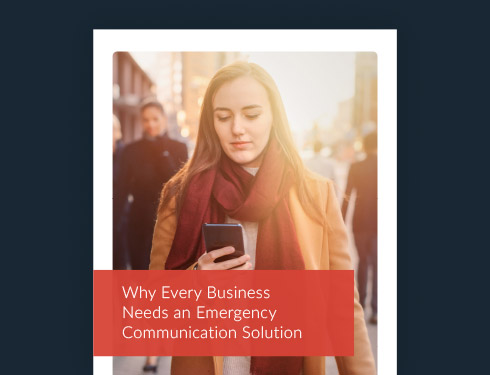
Improving Incident Outcomes With Modern Emergency Communication Tools
David Markley, Director of Operations at Grace Covenant Church, shares the tools and strategies he uses to effectively communicate with his employees, volunteers, and congregation during emergency situations.

It’s not easy to secure huge campuses, multiple buildings, and hundreds if not thousands of employees and visitors. Emergency communications can be a complicated challenge for organizations with a large geographic footprint and a steady flow of people coming in and out of their facilities.
In a recent episode of The Employee Safety Podcast, David Markley, Director of Operations at Grace Covenant Church, shares the tools and strategies he uses to effectively communicate with his employees, volunteers, and congregation during emergency situations.
David has broad executive experience in technology commercialization, product development, and sports management within both large international corporations and small start-up companies. He also has extensive experience in the start-up and operation of soccer franchises and is now applying his corporate experience to the management of business operations for the church.
You can listen to the full episode below.
Q&A With David Markley, Director of Operations at Grace Covenant Church
What are some of the unique challenges or emergencies you’ve experienced at Grace Covenant Church?
On Monday through Friday, our office looks like any other office. On Sundays, however, we’re running large events with thousands of people. We might have 2,000 people on the campus at one time attending different events. We have full-time staff members, volunteers, and a large campus with multiple buildings. What is unique about our organization is that we often have people attending events that are in some kind of distress. Someone might have a domestic situation going on or addictions they’re trying to combat. There might be homeless people coming onto our campus, some of whom may have a mental illness. We’ve encountered that on numerous occasions. When dealing with the distressed, we treat everyone with respect. However, we also have to ensure that everybody feels comfortable and safe coming in and taking part in the ministries.
There are also medical concerns anytime you gather thousands of people. We always plan for the worst-case scenario, but what’s most likely are minor medical incidents. Whether it’s a trip and fall or somebody twisting their ankle, we’re responsible for the care of our congregants. In the case of a medical emergency, we will certainly call 911, but we also want to be able to help our people in the meantime before they arrive.
Do you have an example of an emergency when communication could have been improved?
“"Don't wait until you have the perfect system in place; put a system in place, and then perfect it."”David Markley Director of Operations at Grace Covenant Church
There was an incident shortly after I started working at the church where one of our elderly congregants fainted. Somebody in the class contacted one of our pastors, who called me. They asked if there was a member of our medical team available to help. I happened to be within eyesight of a former Navy paramedic, so I asked them to go check on her. When I got there, they notified me that they had called 911. Then I used our radio to let the security team know that I was going to greet EMS and direct them to the right building.
So I was using a radio to communicate with security while simultaneously calling and texting different pastors to let them know what happened. If you think about the sheer number of ways we used to communicate in that instance, there were a lot of potential places for breakdown. What if I hadn’t been there? What if I hadn’t picked up my phone? That’s when I realized there was a need for a better communication tool than what we had in our arsenal at that time.
What was your improvement plan after that experience? Did you make any changes to your policies or tools after that emergency?
We previously used a limited, one-way communication tool that couldn’t provide actionable information. I started looking for a different tool that would allow us to have two-way communication with staff members. We needed a tool we could use during the workweek, but also when running an event to communicate with different audiences like doctors and nurses in attendance. In the previous situation that I mentioned, if we had had the ability to instantly send a message across different channels to the doctors and nurses in attendance, we could’ve provided help more quickly. This highlighted the need for a modern communication tool that could improve response times and the likelihood of positive outcomes.
I stumbled across AlertMedia and I saw that they had the ability to create communication templates that could be targeted to different audiences. You can quickly pull up a template, modify it as needed, and then hit send to your targeted audience. Your messaging could go to the medical team, to your security team, or to an additional group of people for awareness of what is going on. The ability to tailor our communication for a midweek scenario with our full-time staff or a weekend scenario where there are thousands of people on our campus has been a game-changer for us.
How do you think the new solution will help you move forward?
We frequently have people coming in and asking for money. No matter how much respect you treat them with, they might not like the answer if we’re not able to support them. We had one scenario where a gentleman came in trying to cause a disturbance. At the time, our receptionist was hesitant to use the tool in hand because of that limited communication capability I mentioned before. Today, our ability to create tailored messages for targeted audiences will help us better manage those types of incidents going forward.
How will improved communication affect the need for constant situational awareness for you and your staff?
I was recently talking to a longtime member after one of our services, and I said, “You know, in your role as a greeter, you’re actually serving a security role. You’re filtering people coming through, and you may see a need to notify our team via AlertMedia.” Within 15 minutes, I added him to the system and trained him to send or receive alerts. If you think about it, we’ve now multiplied the number of people on our security team. We’ve multiplied the number of eyes that can now report, “Hey, there’s a suspicious person in this area. Somebody may want to follow up and check on that.” Now we can get two steps ahead of emergencies instead of being two steps behind.
What can someone do today to improve their emergency communications or response?
My simple advice is don’t wait. I’ll tell you about a situation where I could have done better. We were ready to roll out AlertMedia, and I thought the best way to do that was to get together, explain the app, share why it was important, and have everybody download and practice using it on-site. When I was ready to roll it out, we had to shut down services because of COVID. All of a sudden, we could no longer get together in person and were meeting remotely. As we gradually re-opened, a police officer came to me one Sunday and said that there had been a shooting only about a mile from our campus. While there was not a violent threat directly on our campus, we needed to notify our congregants. Since I had not rolled AlertMedia out yet, I had limited communication options.
Our senior pastor was able to communicate to our people what was going on and let them know it wasn’t a good Sunday to linger or go out to eat, but instead to go home and be safe. But again, we have a large campus and so to get the word out to everybody across different buildings required the Paul Revere method. I waited to roll out a tool that would have been extremely useful during that incident. So I rolled it out the next week. The point is don’t wait until you have the perfect system in place; put a system in place, and then perfect it.




![6 Steps to Creating an Effective Emergency Response Plan [+ Template]](https://www.alertmedia.com/wp-content/uploads/2023/10/Blog-Emergency-Response-Plan.webp)
